This is for authentic Swiss or French fondue, which is my personal favorite. “Fondue” comes from the French verb fondue, which means “to melt.” So theoretically “la fondue” could be anything cooked in something melted, although in Switzerland and France this traditionally connotated something cooked in cheese, oil, or broth. Since the 1950’s in America, chocolate has perhaps become the preferred substance for melting both in the states and worldwide.
This recipe is for the Swiss traditional cheese fondue, or what in France is called “fondue au formage.” If you are like my family, you may prefer the quick and easy Americanized version of the Swiss cheese fondue from the Melting Pot. Or you can experiment with cheddar or other cheese fondues. However, this authentic version is my personal favorite.
The allure of cheese lies not just in its taste but in its reflection of human history, tradition, and innovation. French Comté and Swiss Gruyère stand as prime examples, deeply entrenched in their respective cultures. Produced in the Alpine regions, they share similarities while boasting distinct characteristics. Crafted in large copper vats from raw cow’s milk, these cheeses hold a rich tapestry of flavors awaiting exploration. Renowned globally, they spark spirited debates among cheesemongers about preferred ages and styles. Dive into their story, savor their complexities, and uncover your own appreciation.
Alpine cheese-making, spanning eight European countries, has roots reaching back centuries. Grazing cows on lush mountain pastures led to the necessity of transforming excess milk into enduring staples. Enduring harsh winters, these hardy cheeses became integral to local diets and cultures.
Gruyère, named after the Swiss town of Gruyères, and Comté, from the Jura region, once carried the name Gruyère de Comté before being abbreviated in 1986. Both hold esteemed certifications such as AOC (Appellation d’Origine Contrôlée) and PDO (Protected Designation of Origin), dictating strict guidelines for production, including cow breed, raw milk usage, geographical origin, and aging duration. These hefty wheels, sometimes exceeding 70 pounds, demand substantial milk volumes, often sourced from cooperative dairies. Affineurs then take on the crucial role of maturing and refining the cheeses until they reach perfection.
Aging on wooden planks and regularly turned, Comté and Gruyère develop nuanced flavors over time. Despite being washed-rind cheeses, their ample surfaces prevent the typical tackiness associated with such varieties. Comté ages for a minimum of four months, evolving its flavor spectrum from sweet green pea to robust brothy notes, culminating in a texture enriched with crunchy calcium crystals and toasted nutty hints. Meanwhile, Gruyère, with its savory profile and prominent washed-rind flavors, progresses from creamy and nutty to an intensified umami essence reminiscent of sautéed onions.
While similarities abound, the distinguishing factor lies in their flavor profiles, reflective of their unique terroirs. Comté embodies supple smoothness in its youth, transitioning to deeper complexities with age, while Gruyère maintains a savory allure from the start, evolving into an umami-rich delight. Savvy affineurs discern these subtle nuances, ensuring each wheel reaches its peak before reaching consumers.
Whether enjoyed in traditional Swiss fondue or French onion tart, both cheeses complement a variety of dishes. Perfect for a picnic or snack alongside fruit, charcuterie, bread, and wine, Comté and Gruyère invite exploration and appreciation. Ultimately, tasting is believing, and experiencing these cheeses firsthand is the surest path to discerning their distinct charms.
WINE PAIRING FOR CHEESE FONDUE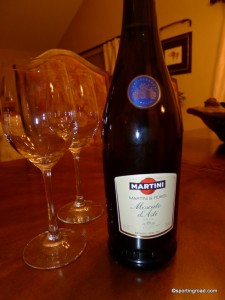
Either way, we suggest pairing any cheese fondue with a dry Swiss wine, or something like Sauvignon blanc, making sure it’s well-iced, to offset the richness of the melted cheese. We also love Martini Moscati d’Asti which is deliciously sweet but not over powering with fondue.
LE FORMAGE – CHOOSING THE CHEESE
Fondue is so popular in Switzerland and many of the Jurassic parts of France (those that border on the Jura Mountain Range, which separates France and Switzerland) that cheese vendors almost always sell a ‘pre-made mix’ of cheeses, already grated and ready to go. Only difference from that in the States, is that the grating is done fresh daily in Europe, sans preservatives and anti-congulating chemicals, which is why the starch is incorporated therein and below.
LE RECEIPE FOR LE FONDUE IS SIMPLE
Fondue is simple. This is peasant food. Not something for fine dining or haute cuisine. You just heat up some white wine with a little chopped garlic, add a few handfuls of cubed or grated cheese and a bit of cornstarch, then heat it up slowly while stirring, almost constantly to avoid burning, until it’s thick and creamy.
SELECTING CHEESES FOR FONDUE – LE FORMAGE
While you can theoretically try any cheese, we prefer cheeses from the Jura Mountain Range, which is home to fondue, such as Gruyère, Comté, or Emmenthal
According to many classic recipes, the only recipe is Fondue Moitié-moitié, which means it’s part Gruyère and part Vacherin Fribourgeois. The mix is roughly 60%/40% of the two cheeses. But the interesting part is the 60/40 may tip in either direction, depending on the seasonal variations in the cheeses. Each cheese monger or chef thinks that he or she has the best combination for the particular taste of the season. And the tastes do vary based upon the season and the aging at that particular time. Before being sold, the Gruyère is typically aged for 10 to 12 months and the Vacherin Fribourgeois (which is different from what the French refer to as Vacherin cheese, which is a larger circle of Mont d’Or cheese) gets about 4 to 5 months of aging.
One famous fondue uses a combination of Vacherin Fribourgeois and slightly aged Gruyère. You could use whatever cheese is available, but avoid a dry, well-aged cheese as they tend to be rather salty. We prefer to use cheeses that are less than one year old.
THE FONDUE POT
We prefer to use glazed enameled pots for cheese fondues, because they’re durable and thick enough to stand up to the high heat necessary to melt the cheese and  keep it from becoming stringy. Remember there is only one pot to clean, which is an added benefit of fondue. Further, the pot should be the best you can afford, as it should last a lifetime, so you will only need one. From the modernly available pots
keep it from becoming stringy. Remember there is only one pot to clean, which is an added benefit of fondue. Further, the pot should be the best you can afford, as it should last a lifetime, so you will only need one. From the modernly available pots
LE TECHNIQUE
The fondue is ready when it forms a ‘skin’ across the hole in the spoon. The traditional spoon for cooking fondue has a hole in the middle. While you can use a traditional wooden spoon, you should show some flair by having the “traditional wooden spoon for fondue” which is the one with the hole in the center. The skin on the cheese begins to form just when the cheese mixture reaches the just-right texture of thickness and stickiness. You can add some kirsch to the cheese mixture at this point, but we usually prefer it without or just a few drops. We recommend to take the traditional shot of kirsch for the chef, straight up, and then just pour the remaining drops left in the shot glass, into the fondue pot. Some other liked minded people prefer to dip the bread in a glass of kirsch before swirling it around in the cheese, rather than putting the kirsch in the cheese. Whatever way you do it, just a touch of kirsch will do, which we don’t know of anyone who really craves this stuff straight-up outside of the factory.
THE TRADITIONAL DESSERT AFTER CHEESE FONDUE
Raisins secs à la lie, golden raisins macerated in marc (clear distilled brandy) along with a cold scoop of vanilla ice cream is considered the classic dessert after cheese fondue.
THE BREAD FOR DIPPING IN CHEESE FONDUE
Choose a dense white bread with a nice crust. Whatever you use, it should be thick-cut and on the drier side but not crispy. When the fondue is finished, the hardened cheese at the bottom of the pot, called la religieuse is generally peeled out and broken with the fingertips as sort of a jerky type of treat broken up for those who survived the course to enjoy the crispy rewards.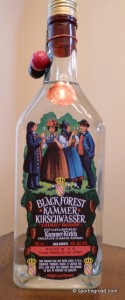
INGREDIENTS:
- 1 1/2 to 2 c. dry white wine
- 1 cloves garlic, peeled and minced
- 2 t. potato starch or cornstarch
- 1 1/2 lbs. mixed grated cheese, such as Gruyère and Emmenthal (but Beaufort also works nicely)
- 1 to 2 t. kirsch
- one loaf challah or egg bread
- apple slices, preferably Granny Smith, for dipping
- we also like vegetables for dipping, such as broccoli, carrots and cauliflower
INSTRUCTIONS:
1. In a sturdy pot, preferably an Emile Henry fondue pot (which is a very big pot at 2.6 qt=83.2 oz.), wipe the pot with a crushed clove of garlic. For more garlic flavor, the garlic can be chopped and added to the pot. Then, on the stove top, add 1 1/2 cup white wine, and the starch.
2. Add the grated cheese and cook over moderately high heat, stirring often, until the cheese is melted and smooth. The fondue is done when the mixture leaves a skin in the hole of the spoon.
3. If the mixture is too thick, add up to 1/2 cup more white wine until its texture is to your liking. If you wish, now is the time to add the kirsch.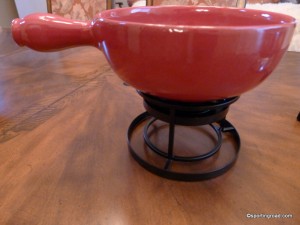
4. Serve warm, preferably in a fondue pot over a table-top flame.
Notes: Because of geographical differences, you may or may not be able to obtain the exact same cheeses that are called for here. But Emmenthal, Gruyère, and Comté are widely available, although as one commenter noted, Emmenthal (sometimes spelled ‘Emmental”) can be stringy when melted. Vacherin Fribourgeois is a softer cheese, and if you can’t find it, Fontina would make a good substitute.
In place of the Kirschwasser, some people add a squeeze of lemon juice to prevent the cheese from clumping, or to fix a broken fondue, which is a handy trick to remember.

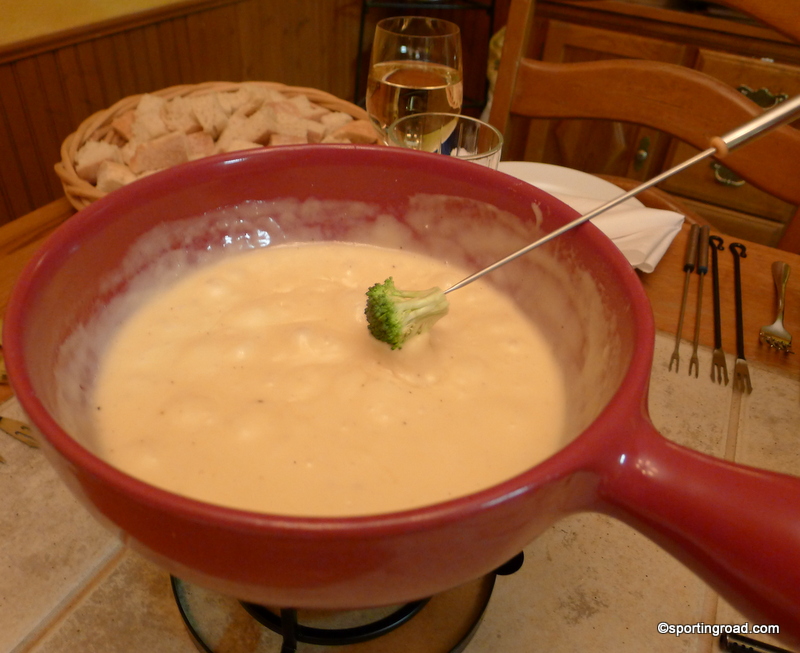
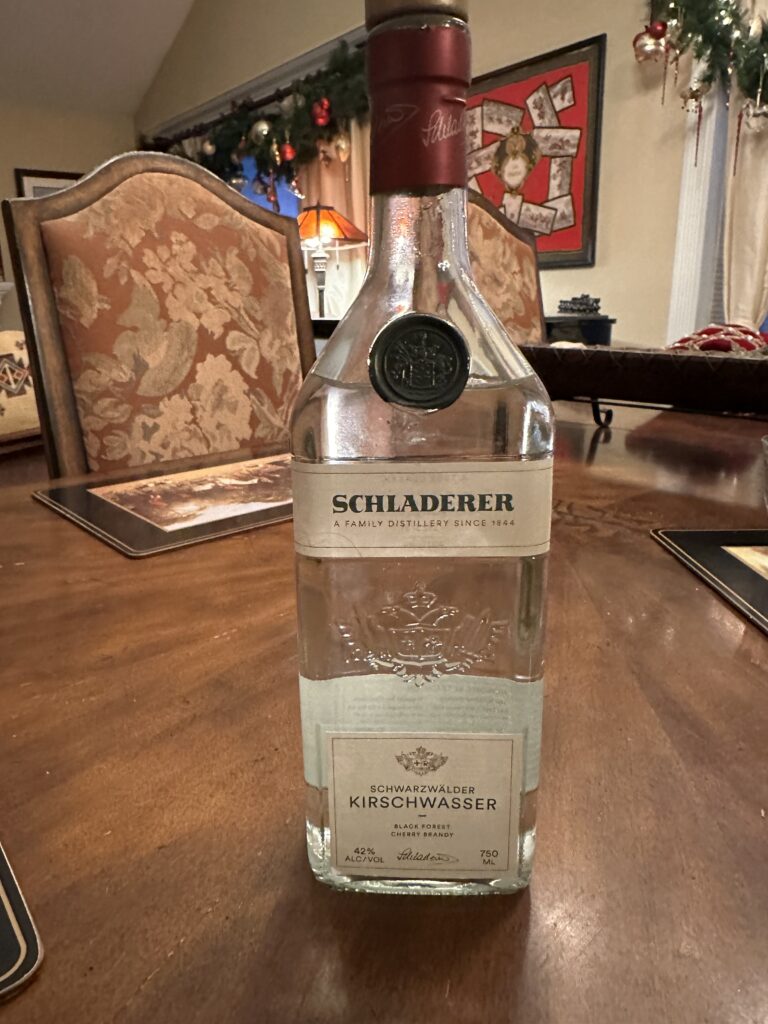
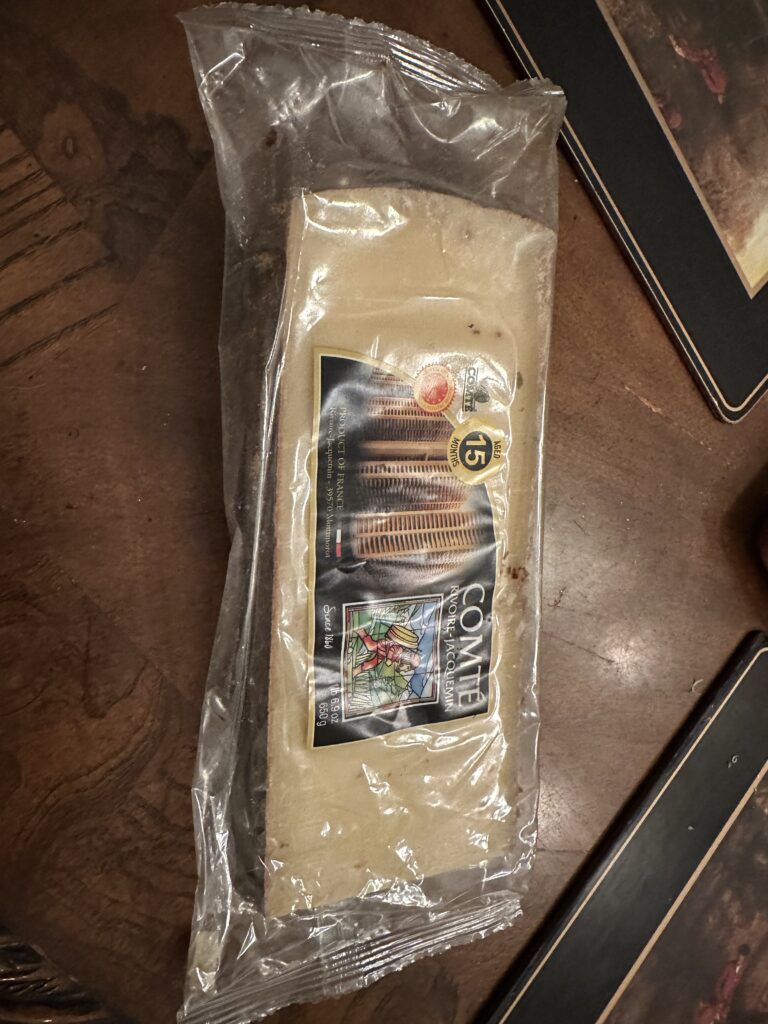
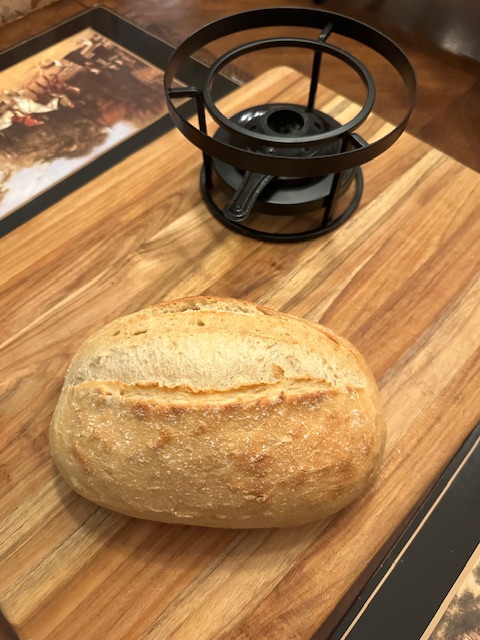
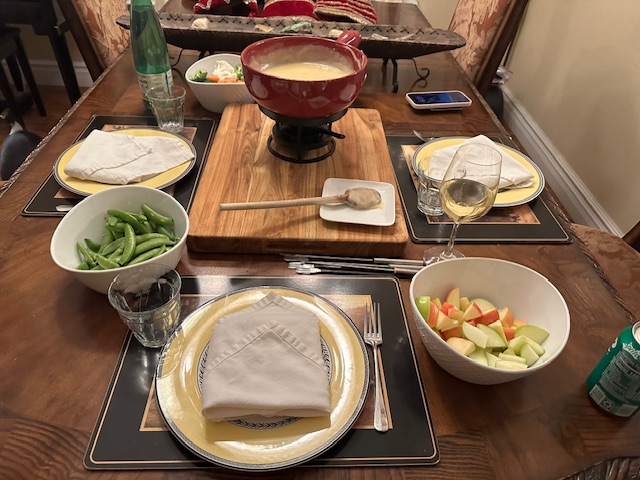
Leave A Comment
You must be logged in to post a comment.